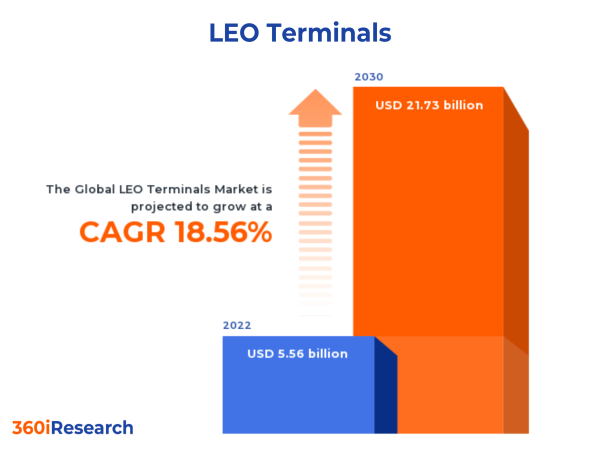The Global LEO Terminals Market to grow from USD 5.56 billion in 2022 to USD 21.73 billion by 2030, at a CAGR of 18.56%.
PUNE, MAHARASHTRA, INDIA , December 7, 2023 /EINPresswire.com/ -- The "LEO Terminals Market by Platform (Fixed, Mobile), Frequency (C-Band, HF/VHF/UHF-Band, Ka-Band), Application, End Use - Global Forecast 2023-2030" report has been added to 360iResearch.com's offering.The Global LEO Terminals Market to grow from USD 5.56 billion in 2022 to USD 21.73 billion by 2030, at a CAGR of 18.56%.
Request a Free Sample Report @ https://www.360iresearch.com/library/intelligence/leo-terminals?utm_source=einpresswire&utm_medium=referral&utm_campaign=sample
LEO terminals are critical ground-based infrastructure components for effectively operating Low-Earth Orbit (LEO) satellite communication systems. LEO terminals serve as the interface between LEO satellites and the end-users on the ground, facilitating two-way communication. LEO terminals comprise antennas, transceivers, and other electronic components designed to track LEO satellites that move rapidly across the sky due to their lower orbit and faster orbital speed than GEO satellites. Increasing demand for enhanced connectivity and deployment of satellites are raising the need for efficient LEO Terminals globally. However, high costs and risks associated with data breaches may adversely impact the deployment of LEO terminals. Moreover, advancements in LEO terminal components are anticipated to increase their deployment across end-use applications worldwide.
Application: Evolving usage of LEO terminals in earth observation and remote sensing
LEO terminals offer high-speed data transmission and enhanced overall communication services. LEO satellite terminals exceed geostationary satellites, offering more efficient data transfer and connectivity with negligible latency. Additionally, terminals provide global coverage, including hard-to-reach areas, making them suitable for maritime, aviation, and remote land communications. The telecommunication sector benefits tremendously from LEO operations, providing essential functions such as voice and video, broadband services, and complex processes involving machine-to-machine communication, cloud-based applications, and IoT connectivity. Due to their proximity to the earth's surface, LEO terminals transmit high-resolution imagery ideal for accurate geographical data collection and mapping. Remote sensing satellites in LEO also aid significant sectors such as agriculture and defense. LEO terminals provide valuable data for precision agriculture, including information on soil health, crop growth, and pest infestation.
End Use: Burgeoning adoption of LEO terminals in government and military sector
In the commercial sector, LEO terminals are increasingly employed in industries that demand robust, real-time connectivity solutions, such as telecommunications, broadcasting, and remote sensing. LEO terminals have enabled unprecedented levels of broadband speed, with advancements in satellite communication, ensuring hassle-free online communication from remote locations. The government and military sector, another significant adopter of LEO terminal technology, utilizes it for secure communication, earth observation, and remote sensing. LEO technology is ideal for military applications such as surveillance, navigation, and reconnaissance due to its lower latency and ability to cover vast geographies.
Frequency: Increasing utilization of ultra-high frequency (UHF) band for data transmission
C-Band is majorly used for satellite communication and balances range and resolution and is less susceptible to rainfall attenuation than higher range bands. The high frequency operates within 3-30 MHz, very high frequency within 30-300 MHz, and ultra-high frequency within 300 MHz to 3 GHz. They are suitable for radio communication, TV broadcasting, and data transmission. The Ka-Band frequency varies between 26.5 GHz and 40 GHz, offering high-speed data communication, often utilized in broadband satellite networks and spacecraft communication. The Ku-Band operates within 12-18 GHz frequency, making it suitable for satellite television and radio broadcasts, maritime communications, and several military applications. Operating within the 1-2 GHz frequency range, the L-Band is primarily used for global positioning systems (GPS), mobile satellite services, and aircraft surveillance. Laser or optical communication uses light in the visible to near-infrared spectrum. The Q/V-Band frequencies range between 33 GHz and 75 GHz, which offers high-capacity data transfer; however, it can be attenuated by atmospheric conditions. The S-Band operates between 2-4 GHz due to strong signal penetration and less restriction, making it ideal for navigation systems and long-range radar applications. The X-Band operates within 8-12 GHz frequency and is widely used for military communications, weather monitoring, and radar applications.
Platform: Growing preference for mobile LEO terminals owing to their flexibility in establishing a connection
Fixed LEO terminals establish static connection points and are usually installed at specific strategic locations such as telecommunication hubs, data centers, and satellite ground stations. Fixed LEO terminals usually offer more steady and higher data transfer rates as they have larger antennas and are often positioned in locations with a clear, unobstructed line of sight to the sky. Fixed terminals are vital in providing Internet connectivity in remote regions and temporary worksites lacking terrestrial infrastructure. Mobile LEO terminals offer the flexibility and adaptability of establishing a connection from any place. Mobile LEOs are portable units that can be set up on vehicles, vessels, or aircraft.
Regional Insights:
The Low Earth Orbit (LEO) terminals market is evolving in the Americas owing to the increasing space innovation, presence of significant players, well-established technological infrastructure, and customer base within this region. In Europe, LEO satellite initiatives are bolstered by a strong emphasis on closing digitalization and connectivity, providing coverage for rural and remote areas, and augmenting existing networks. The Middle East and Africa are regions where LEO terminals can potentially significantly impact, especially in regions afflicted with underdeveloped terrestrial infrastructure. The Asia-Pacific (APAC) region presents a high-growth potential for the LEO terminal market owing to rapidly increasing investments in space technology and focus on establishing LEO networks to provide nationwide coverage. Besides, significant investments for expanding LEO terminal infrastructure are anticipated to propel the growth of the LEO terminal market globally.
FPNV Positioning Matrix:
The FPNV Positioning Matrix is essential for assessing the LEO Terminals Market. It provides a comprehensive evaluation of vendors by examining key metrics within Business Strategy and Product Satisfaction, allowing users to make informed decisions based on their specific needs. This advanced analysis then organizes these vendors into four distinct quadrants, which represent varying levels of success: Forefront (F), Pathfinder (P), Niche (N), or Vital(V).
Market Share Analysis:
The Market Share Analysis offers an insightful look at the current state of vendors in the LEO Terminals Market. By comparing vendor contributions to overall revenue, customer base, and other key metrics, we can give companies a greater understanding of their performance and what they are up against when competing for market share. The analysis also sheds light on just how competitive any given sector is about accumulation, fragmentation dominance, and amalgamation traits over the base year period studied.
Key Company Profiles:
The report delves into recent significant developments in the LEO Terminals Market, highlighting leading vendors and their innovative profiles. These include AvL Technologies, Cobham Limited, DataPath, Inc., EchoStar Corporation, Hughes Network Systems, LLC, Hytera Communications Corporation Limited, Intellian Technologies, Inc., Iridium Communications Inc., Kymeta Corporation, L3Harris Technologies, Inc., ND SatCom GmbH, Satixfy UK Limited, STMicroelectronics N.V., TE Connectivity, Thales Group, The Boeing Company, and Viasat, Inc..
Inquire Before Buying @ https://www.360iresearch.com/library/intelligence/leo-terminals?utm_source=einpresswire&utm_medium=referral&utm_campaign=inquire
Market Segmentation & Coverage:
This research report categorizes the LEO Terminals Market in order to forecast the revenues and analyze trends in each of following sub-markets:
Based on Platform, market is studied across Fixed and Mobile. The Mobile is projected to witness significant market share during forecast period.
Based on Frequency, market is studied across C-Band, HF/VHF/UHF-Band, Ka-Band, Ku-Band, L- Band, Laser/Optical, Q/V- Band, S-Band, and X-Band. The L- Band is projected to witness significant market share during forecast period.
Based on Application, market is studied across Communication and Earth Observation & Remote Sensing. The Communication is projected to witness significant market share during forecast period.
Based on End Use, market is studied across Commercial and Government & Military. The Government & Military is projected to witness significant market share during forecast period.
Based on Region, market is studied across Americas, Asia-Pacific, and Europe, Middle East & Africa. The Americas is further studied across Argentina, Brazil, Canada, Mexico, and United States. The United States is further studied across California, Florida, Illinois, New York, Ohio, Pennsylvania, and Texas. The Asia-Pacific is further studied across Australia, China, India, Indonesia, Japan, Malaysia, Philippines, Singapore, South Korea, Taiwan, Thailand, and Vietnam. The Europe, Middle East & Africa is further studied across Denmark, Egypt, Finland, France, Germany, Israel, Italy, Netherlands, Nigeria, Norway, Poland, Qatar, Russia, Saudi Arabia, South Africa, Spain, Sweden, Switzerland, Turkey, United Arab Emirates, and United Kingdom. The Americas commanded largest market share of 35.47% in 2022, followed by Europe, Middle East & Africa.
Key Topics Covered:
1. Preface
2. Research Methodology
3. Executive Summary
4. Market Overview
5. Market Insights
6. LEO Terminals Market, by Platform
7. LEO Terminals Market, by Frequency
8. LEO Terminals Market, by Application
9. LEO Terminals Market, by End Use
10. Americas LEO Terminals Market
11. Asia-Pacific LEO Terminals Market
12. Europe, Middle East & Africa LEO Terminals Market
13. Competitive Landscape
14. Competitive Portfolio
15. Appendix
The report provides insights on the following pointers:
1. Market Penetration: Provides comprehensive information on the market offered by the key players
2. Market Development: Provides in-depth information about lucrative emerging markets and analyzes penetration across mature segments of the markets
3. Market Diversification: Provides detailed information about new product launches, untapped geographies, recent developments, and investments
4. Competitive Assessment & Intelligence: Provides an exhaustive assessment of market shares, strategies, products, certification, regulatory approvals, patent landscape, and manufacturing capabilities of the leading players
5. Product Development & Innovation: Provides intelligent insights on future technologies, R&D activities, and breakthrough product developments
The report answers questions such as:
1. What is the market size and forecast of the LEO Terminals Market?
2. Which are the products/segments/applications/areas to invest in over the forecast period in the LEO Terminals Market?
3. What is the competitive strategic window for opportunities in the LEO Terminals Market?
4. What are the technology trends and regulatory frameworks in the LEO Terminals Market?
5. What is the market share of the leading vendors in the LEO Terminals Market?
6. What modes and strategic moves are considered suitable for entering the LEO Terminals Market?
Read More @ https://www.360iresearch.com/library/intelligence/leo-terminals?utm_source=einpresswire&utm_medium=referral&utm_campaign=analyst
Mr. Ketan Rohom
360iResearch
+ +1 530-264-8485
[email protected]




